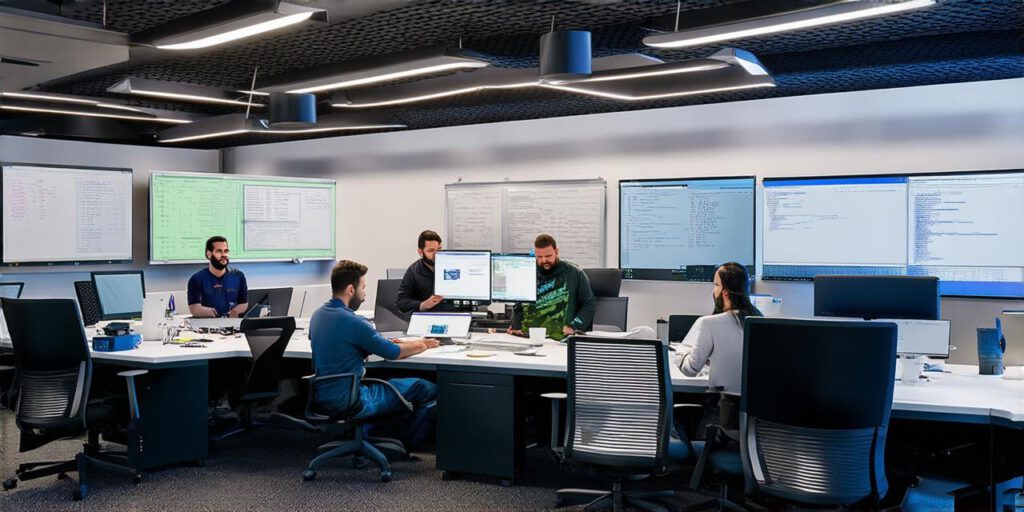Development teams are groups of individuals responsible for creating and maintaining software applications. They work together to design, develop, and test software systems that meet the needs of their clients or end-users.
What is a Development Team?
A development team consists of individuals with different skills and expertise who work together to create software applications. The team typically includes developers, designers, testers, project managers, and other stakeholders who collaborate throughout the software development process. Each team member brings their unique skills and experience to the table, allowing them to work together effectively to create high-quality software systems.
The Roles of a Development Team
There are several roles within a development team that contribute to the success of the project. These include:
- Developers: Developers are responsible for writing code, testing and debugging it, and ensuring that it meets the requirements of the software application. They work with the design team to create the user interface and ensure that the code is efficient, scalable, and maintainable.
- Designers: Designers are responsible for creating the user interface of the software application. They work closely with the developers to ensure that the design is functional, visually appealing, and meets the needs of the end-users. The designers also collaborate with the project manager to ensure that the project stays on track and within budget.
- Testers: Testers are responsible for testing the software application to ensure that it meets the requirements and specifications. They identify any bugs or issues that need to be fixed before the software is released. The testers also collaborate with the developers to ensure that the code is efficient, scalable, and maintainable.
- Project Managers: Project managers are responsible for overseeing the software development process. They create project plans, allocate resources, and manage timelines. They also communicate with stakeholders to ensure that the project stays on track and within budget. The project manager collaborates with the other team members to ensure that the software application meets the requirements of the end-users.
- Other Stakeholders: Other stakeholders, such as product managers, analysts, and end-users, are also involved in the software development process. They provide feedback on the software’s features and functionality, and they help to ensure that the software application meets their needs.
Case Studies: Real-Life Examples of Development Teams
Let’s take a look at some real-life examples of development teams at work.
Example 1: Agile Development Team
An agile development team is a group of individuals who follow the Agile methodology for software development. They work collaboratively to create software applications in an iterative and incremental manner. The team includes developers, designers, testers, project managers, and other stakeholders who work together to deliver working software in short iterations.
The agile team follows a set of principles that emphasize flexibility, collaboration, and continuous improvement. They use tools such as scrum boards, sprint retrospectives, and daily stand-ups to ensure that they stay on track and meet their goals. The agile team also uses agile methodologies such as user stories and test-driven development to create high-quality software applications.
Example 2: DevOps Team
A DevOps team is a group of individuals who are responsible for the development, operations, and maintenance of software applications. They work closely together to ensure that the software is delivered quickly and reliably to the end-users. The DevOps team includes developers, designers, testers, operations engineers, and other stakeholders who collaborate throughout the software development process.
The DevOps team uses a set of tools and practices such as continuous integration and deployment, infrastructure as code, and automation to ensure that the software is delivered quickly and reliably. They also use monitoring and analytics tools to ensure that the software is running smoothly and meet the end-users’ needs.
Example 3: Scrum Development Team
A scrum development team is a group of individuals who follow the Scrum methodology for software development. They work collaboratively to create software applications in an iterative and incremental manner. The team includes developers, designers, testers, project managers, and other stakeholders who work together to deliver working software in short iterations.
The scrum team follows a set of roles such as product owner, scrum master, and development team members. The product owner is responsible for defining the requirements of the software application and prioritizing them based on the end-users’ needs. The scrum master facilitates the scrum process, ensuring that the team stays on track and meets their goals. The development team members are responsible for writing code, testing and debugging it, and ensuring that it meets the requirements of the software application.
The Benefits of Development Teams
Development teams have several benefits, including:
- Improved Communication: Development teams bring together individuals with different skills and expertise to work collaboratively on a software development project. This collaboration helps to improve communication between team members, leading to better understanding of the project requirements and improved quality of the software application.
- Increased Efficiency: Development teams are more efficient than individuals working alone on a software development project. They have access to a broader range of skills and expertise, allowing them to work faster and more efficiently.
- Better Quality Software: Development teams work together to ensure that the software application meets the requirements and specifications. This collaboration helps to improve the quality of the software, leading to a better user experience.
- Improved Flexibility: Development teams are more flexible than individuals working alone on a software development project. They can adapt to changes in requirements or priorities quickly, ensuring that the software application stays up-to-date with the end-users’ needs.
Conclusion
In conclusion, a development team is a group of individuals responsible for creating and maintaining software applications. The team includes developers, designers, testers, project managers, and other stakeholders who collaborate throughout the software development process. Development teams have several benefits, including improved communication, increased efficiency, better quality software, and improved flexibility.
FAQs
If you are interested in working with a development team, there are many resources available to help you get started. You can find online courses, tutorials, and guides that cover topics such as software development methodologies, project management, and agile practices.
With the right tools and knowledge, you can join a development team and contribute to the creation of high-quality software applications.


